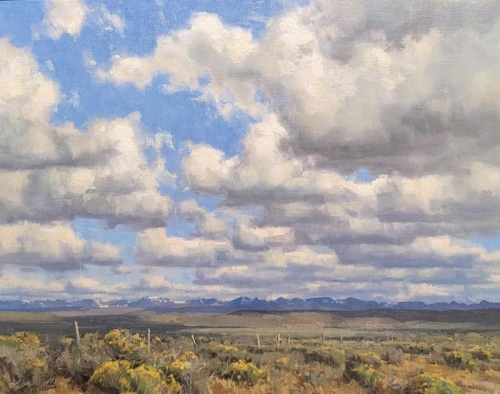Clyde Aspevig
Considered by many to be the foremost representational landscape painter of our time, Clyde Aspevig has exhibited his work at many important museum and gallery shows throughout the country. He is a recent winner of the Gold Medal at the National Academy of Western Art.
Clyde Aspevig was born to Gertrude and Donald Aspevig in 1951 on a farm near Rudyard, Montana, just south of the Canadian Border. At eleven years of age, he fell off a horse and severely broke his leg.
More
Considered by many to be the foremost representational landscape painter of our time, Clyde Aspevig has exhibited his work at many important museum and gallery shows throughout the country. He is a recent winner of the Gold Medal at the National Academy of Western Art.
Clyde Aspevig was born to Gertrude and Donald Aspevig in 1951 on a farm near Rudyard, Montana, just south of the Canadian Border. At eleven years of age, he fell off a horse and severely broke his leg. During his convalescence his uncle, Roald Haaland, an amateur painter, introduced him to oil paints.
In 1969, Aspevig moved to Billings, Montana and began majoring in Art at Eastern Montana College, now Montana State University - Billings. It is here that he began selling his first paintings which were small watercolors.
After receiving his degree in Education, Aspevig moved to Sandy, Oregon where he taught art at Sandy Union High School. He soon moved back to Montana to paint full-time. Aspevig's efforts bode well for him, and success soon followed.
During the late 1970s and 80’s Aspevig began establishing a national reputation for himself. His work was promoted through many one-man shows and prestigious awards he received. At his Grand Central Galleries show in New York City, one of his patron’s commented on how wonderful it was to have "good art" in New York City again.
His deep attachment to the Western landscape is evident in his body of work. He spends considerable time outside communing with the landscape in order to open up his emotions to the psychological aspects of the land around him.
Many young artists are satisfied with that which has given them success. Clyde Aspevig however, continues to seek new challenges and has altered his style. He began suggesting – not replicating – detail. He leaves in just enough to make the viewer believe in the place while leaving the rest to be developed by the power of an individual’s imagination. He says this evokes, "a deeper response than a literal or detailed interpretation".
Less
 "Autumn at Willow Flats"
24" x 36" oil
SOLD
"Autumn at Willow Flats"
24" x 36" oil
SOLD
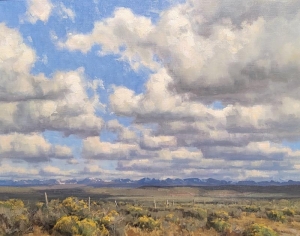 "Wyoming Fenceline"
24" x 30" oil
SOLD
"Wyoming Fenceline"
24" x 30" oil
SOLD
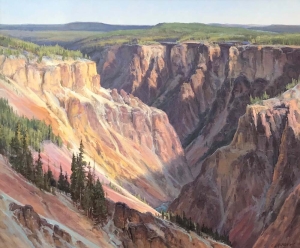 "Grand Canyon of the Yellowstone"
20" x 24" oil
SOLD
"Grand Canyon of the Yellowstone"
20" x 24" oil
SOLD
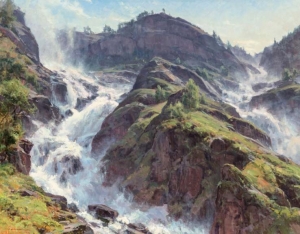 "Rushing to the Sea"
40" x 50" oil
SOLD
"Rushing to the Sea"
40" x 50" oil
SOLD
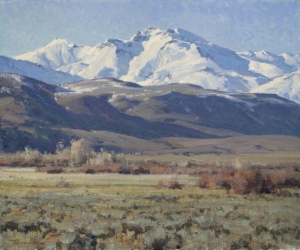 "Nevada Landscape"
20" x 24" oil
SOLD
"Nevada Landscape"
20" x 24" oil
SOLD
 "Rain Showers - Wyoming"
25" x 30" oil
SOLD
"Rain Showers - Wyoming"
25" x 30" oil
SOLD
 "High Mountain Lake"
16" x 20" oil
SOLD
"High Mountain Lake"
16" x 20" oil
SOLD
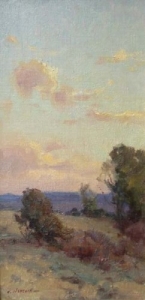 "Evening Cloud"
12" x 6" oil
SOLD
"Evening Cloud"
12" x 6" oil
SOLD
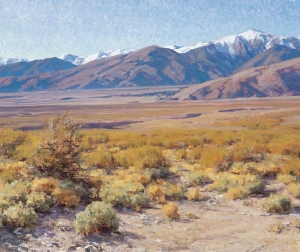 "View of Telescope Peak"
30" x 36" oil
SOLD
"View of Telescope Peak"
30" x 36" oil
SOLD
